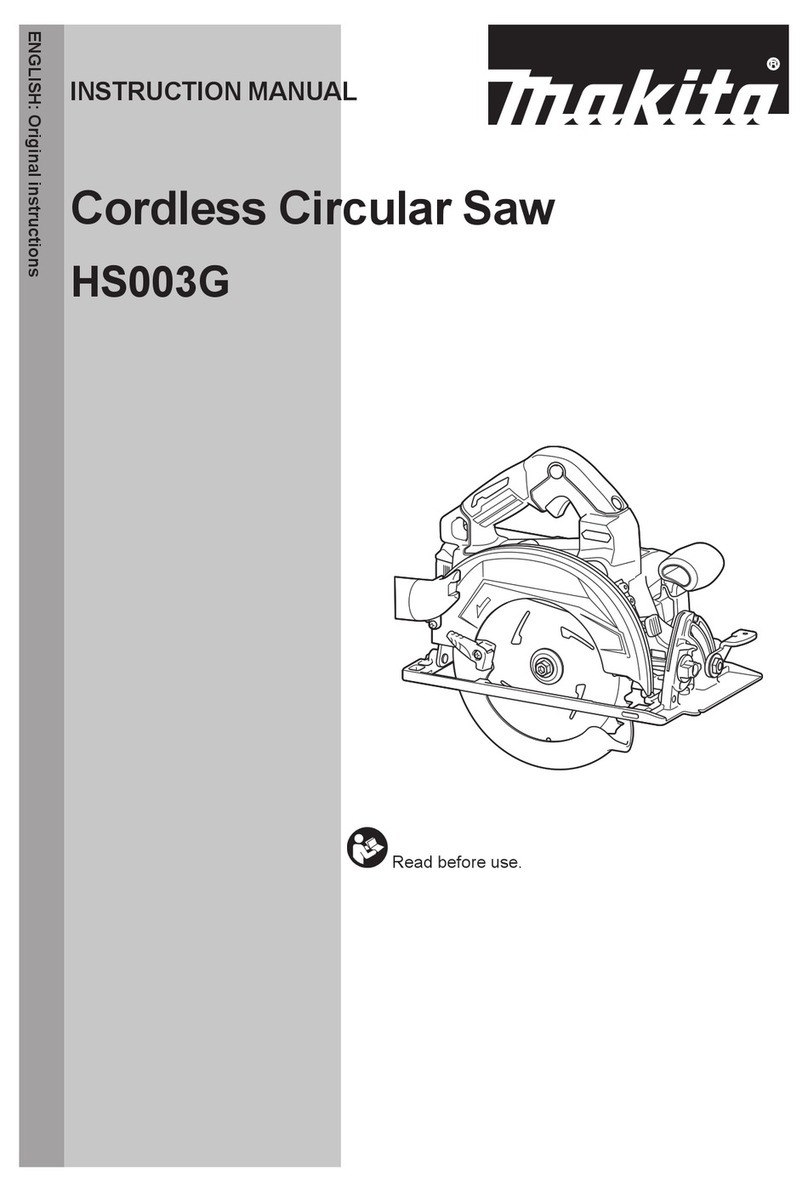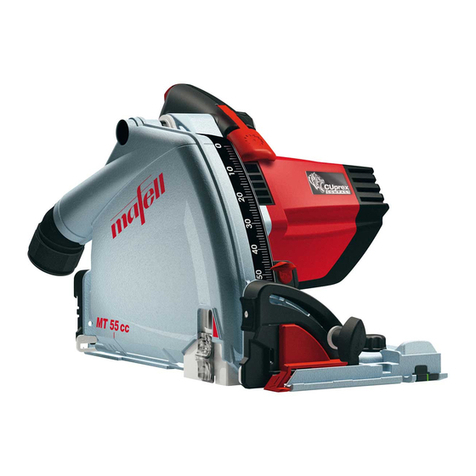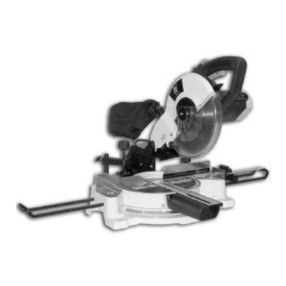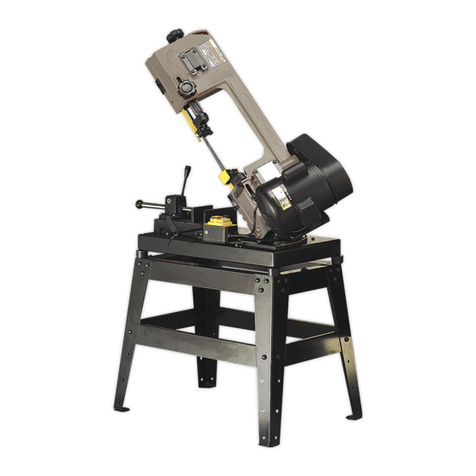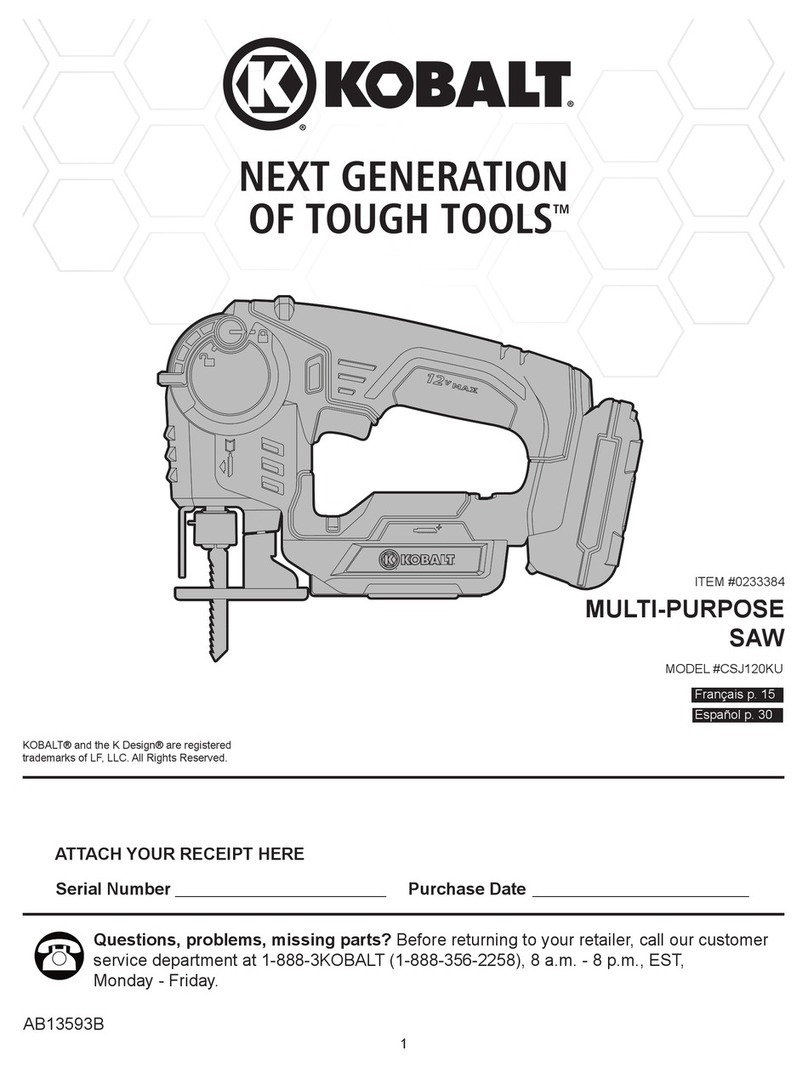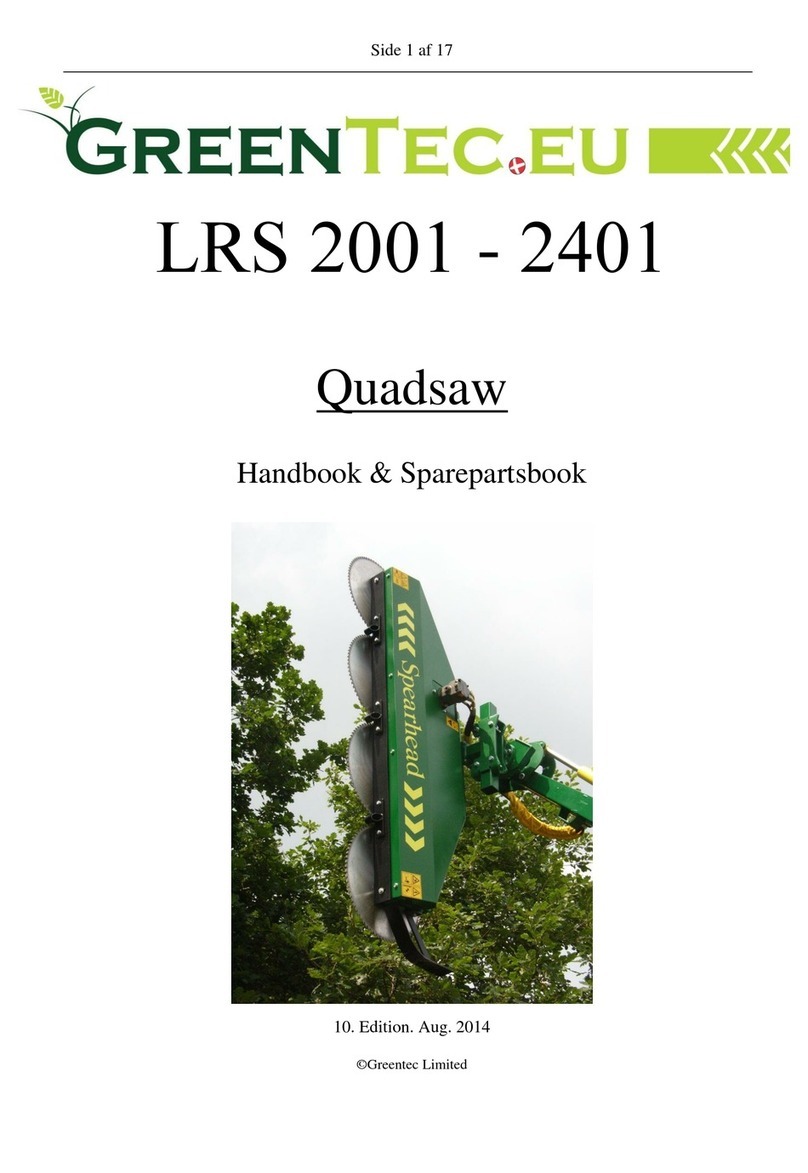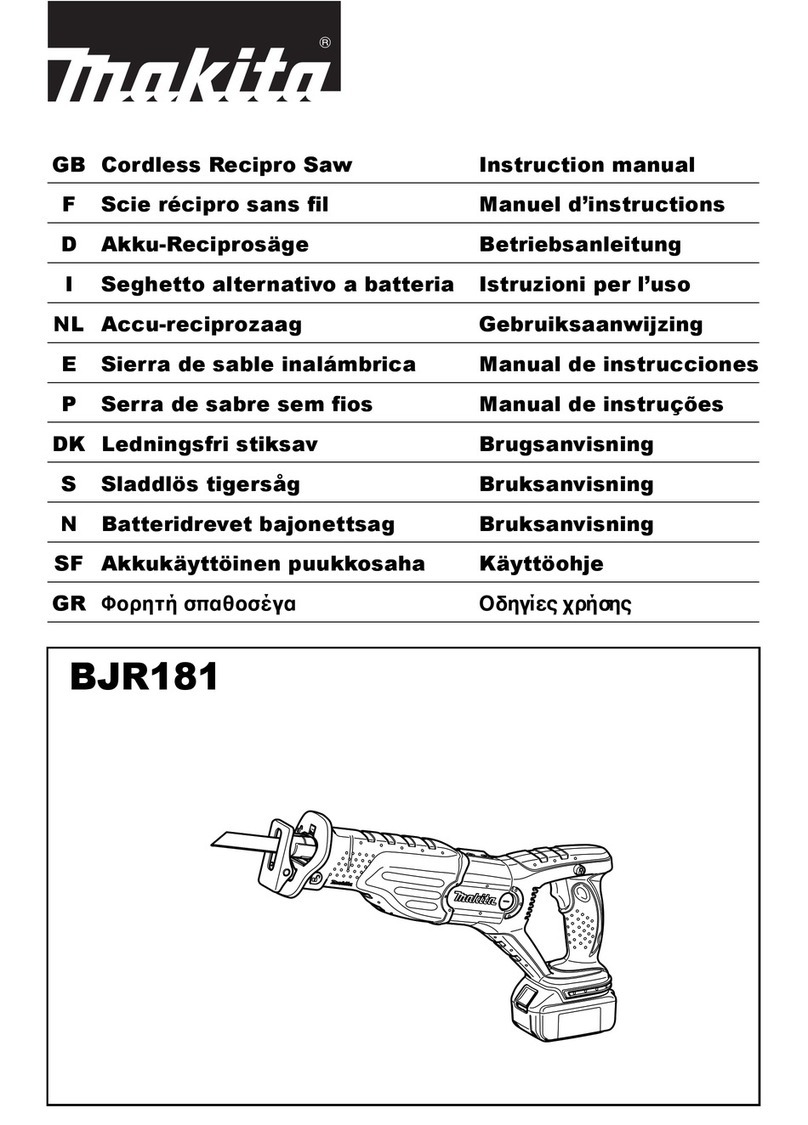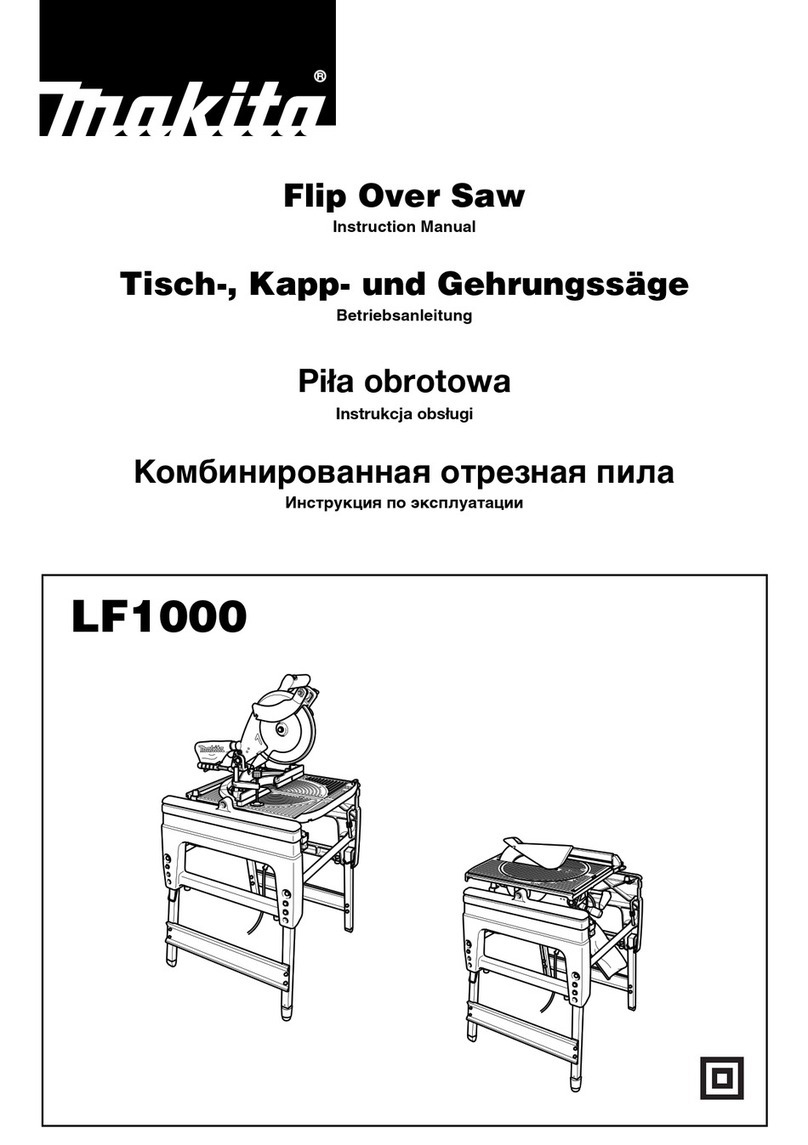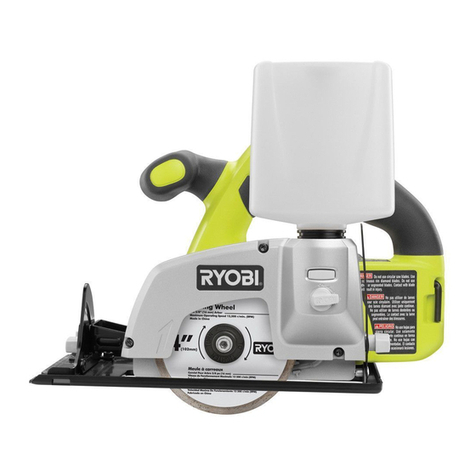GRAULE ZS 135 User manual

Graule Maschinenbau GmbH ,
Robert-Bosch-Str. 7, D-73431 Aalen
Tel: 0049 (0)7361 49511 Fax: 0049 (0)7361 49521, e-mail:info@graule.de
Operating Instructions
Radial Arm Saw
Type ZS 135 - ZS 170
„Wood dust certificated“
Test number 971049

Graule Maschinenbau GmbH ,
Robert-Bosch-Str. 7, D-73431 Aalen
Tel: 0049 (0)7361 49511 Fax: 0049 (0)7361 49521, e-mail:info@graule.de
GRAULE Maschinenbau Gmbh - Robert Bosch Str. 7 - D 73431 Aalen
EC Declaration of Conformity
In accordance with the EC Directive on Machinery
(EC Directive 2006/42/EG)
Hereby the manufacturer
GRAULE Maschinenbau GmbH, Robert-Bosch-Straße 7, D-73431 Aalen - Germany
assures that the machine
Description of the machine: RADIAL ARM SAW
Machine type: ZS 135 and ZS 170
Machine number: _________________
Year of construction: _________________
is conform with the EC Directive on Machinery 2006/42/EG.
Applied harmonized standards in particular which were used at construction and building of machines:
•EN ISO 12100-1 Safety of machinery; Basic concepts, general principles
for design – Part 1
•EN ISO 12100-2 Safety of machinery; Basic concepts, general principles
for design – Part 2
•EN ISO 13850 Safety of machinery; Emergency stop – Principles for design.
•EN ISO 13857 Safety of machinery; Safety distances to prevent hazard zones being reached by
upper and lower limbs
•EN ISO 60204-1 Safety of machinery; Electrical equipment of machines – Part 1
Name of the authorized person to compile the relevant technical documentation at GRAULE GmbH
Date/ Manufacturer's signature: Aalen January 2015 ...................................
R. Graule
(Managing Director)

Graule Maschinenbau GmbH ,
Robert-Bosch-Str. 7, D-73431 Aalen
Tel: 0049 (0)7361 49511 Fax: 0049 (0)7361 49521, e-mail:info@graule.de
1.
1.1 Producer
GRAULE - Maschinenbau GmbH Robert Bosch Str. 7
D-73431 Aalen
Phone: 0049 – 7361 - 49511
Fax: 0049 – 7361 – 49521
1.2 Technical dates
for Radial Arm Saw typ ZS 135 / ZS 170
sawblade diameter 350 / 420 mm
bore 30/40 / 40 mm
cutting range :
cross-cut 90° 430 / 410 mm
mitre cut 45° 300 / 290 mm
cutting height at 90° 135 / 170 mm
mitre range horizontal 45° - 90° - 25°
dust tube diameter 95 mm
weight 100 / 110 kg
motor 3 phases 380-400 Volt , 50 Hz , 2 kW
revolutions 3800 / 3500 rpm
1.3 Noise coefficient ( DIN 45635)
for Radial Arm Saw typ ZS 135 / ZS 170
Schalleistungspegel:
idle motion 95,7 / 100,3 dB(A)
in works 95,4 / 98,6 dB(A)
Arbeitsplatzbezogener Emissionswert:
idle motion 81,8 / 87,5 dB(A)
in works 82,3 / 84,5 dB(A)
2. Standart delivery
Radial Arm Saw without saw blade and without stand
wrench no.17 for changing saw blade
distance ring 30/40 mm at typ ZS 135
extra insert for wooden table
3. Accessories ( option )
for Radial Arm Saw typ ZS 135:
tct saw blade for wood 350 x 4,0 x 40 mm 42 t neg.
tct saw blade for wood 350 x 3,2 x 40 mm 72 t neg.
tct saw blade for upvc and aluminium 350 x 3,5 x 40 mm 108 t neg.
for Radial Arm Saw type ZS 170:
tct saw blade for wood 420 x 4,0 x 40 mm 48 t neg.
tct saw blade for upvc and aluminium 420 x 3,5 x 40 mm 100 t neg.
for both machine types:
stronger motor 3 kW
stand
hydraulic feed control ( hydro check cylinder )
pneumatic spray attachment
pneumatic clamp set
manuel clamp for left hand side
roller guide 300 mm wide, 2 mtr., 3 mtr. oder 4 mtr. long
roller guide including scale and length stop 300 mm widet, 2 mtr., 3 mtr. oder 4 mtr. long
extra fence for cutting small angles
digital read out for the angles
4. Safety devices
With locking device, below the operational grip, block the tool slide into its rear

Graule Maschinenbau GmbH ,
Robert-Bosch-Str. 7, D-73431 Aalen
Tel: 0049 (0)7361 49511 Fax: 0049 (0)7361 49521, e-mail:info@graule.de
position, to prevent pulling forward unintentionally. The saw blade is then perfectly located
in the lower saw blade protecting hood.
The material wooden supporting table with the insert and the vertical back stop shoulder
must always be in good condition. Defective tables and stop shoulders must be replaced.
Return spring device, which withdraws the tool slide into its rear starting position after
a saw cut, must be immediately replaced in case of breakage. The saw must not be operated
when the return spring device is faulty.
The ball-type nipple guide must be cleaned at regular intervals, so that the guiding elements
may run smoothly and the tool slide may be pulled back indipendently into its rear starting
position through the return spring device.
Lower saw blade protecting hood must be correctly set, so that the saw blade is entirely
covered in its lower area. Switch off the machine (disconnect the mains plug!) to remove
residual material fragments which might be got stuck.
CAUTION: Do not operate the machine if parts are damaged! Faulty parts must be
immediately replaced and in the meantime the machine must be stopped!
5. Qualified application.
Circular cross-cut and mitre-box saws type ZS 135 or ZS 170 may only be used for professional
cutting into sections or mitre cutting of following materials: wood with a rectangular or
square cross section, strip cutted panel materials, like particle board, wood core plywood
and Mdf-boards which are made fit for the cutting range, plastic profiles (duroplastic and
thermoplastic) and, in connection with hydraulic feed brakes, hollow extruded aluminium
profiles up to a wall thickness of approx. 4 mm . Profiles must have a safe support. Profile
sections must be adapted to the machining range. The saw blade must match the material to
be cut.
A qualified application also requires that the saw blade has a negative effective cutting
angle.
Any other different application shall be regarded as unsuitable and the manufacturer assumes
no responsibility for resulting damages of any kind. The risk shall be taken by the user alone.
The use of HSS-(high-speed steel) saw blades and cutting-off wheels is not allowed.
The machine must be connected to a large exhaustion plant.
During operation the machine must have a safe location.
A qualified application also requires that the manufacturer meets all specified operation,
maintenance and repair conditions, as well the operation and safety regulations of the
working instructions.
6. Other risks
Owing to the purpose of application of the machine design, the following remaining risks
may arise, even after taking all necessary safety precautions and despite a qualified
application:
•Touching the saw blade during the cutting operation.
•Slinging away of small wood fragments.
•Breaking and slinging out of saw blade parts.
•Damage to hearing during a long operating time without ear protection.
•Emission of harmful dusts during operation without an exhaustion plant.
•Danger of injury through the saw blade tooth when replacing saw blades.
7. Safety notes
The machine may only be operated and attended by people who are familiar with it and well
informed about the dangers. Repairs may only be made by qualified staff.
The machine must be operated in line with all appropriate regulations for prevention of
accidents as well as with the generally accepted requirements about safety and industrial
medicine.
No warranty is given by the manufacturer for any damage resulting from unauthorized
changes on the machine.
Improper use of high-speed machines can be dangerous! Therefore:
•Read the instructions for use carefully before operating the machine.
•Never work without the protective equipment as specified for each operation and do not
change anything in the machine that could be detrimental to its safety.
•Children and young people are not allowed to operate the machine, except for young
people under supervision of an expert for training purposes.

Graule Maschinenbau GmbH ,
Robert-Bosch-Str. 7, D-73431 Aalen
Tel: 0049 (0)7361 49511 Fax: 0049 (0)7361 49521, e-mail:info@graule.de
•Never work without a safety appliance or with a faulty machine or tool.
•Worn out material supporting tables must be immediately replaced.
•Use only circular saw blades allowed for this type of machine.
•The use of cutting-off wheels or circular saw blades out of high-speed steel (HSS) is not allowed.
•Do not use saw blades being cracked or modified in the shape.
•The machine must have a permanent and safe place and must stand horizontally.
•During repairs and when working to eliminate troubles disconnect the mains plug and wait
until the saw blade stops. The same also applies when removing stuck splinters.
•Damaged cables and plugs must be immediately replaced.
•Always wear tight-fitting clothes. Take off any ring, bracelet, watch or chain when working.
•Wear safety glasses when cutting, to protect against chips being thrown around.
•Sound pressure at work place normally exceeds 85 dB (A).
Therefore, wear an ear protection when working.
•Start working only when the saw blade has reached its maximum speed.
•Do not machine any part being too small or too big for the capability of the machine.
•The machining of round woods or parts with an inadequate work support is prohibited.
•Work only with sharp tools.
•Do not work in a damp or wet environment, or in the surrounding area of combustible liquids or gas.
•Wood dust resulting from cutting the wood is harmful to the sight and sometimes to the
health. If you do not work outside or in well ventilated rooms, the machine must be
connected to a shavings exhaustor with at least a 20 m/s air speed. The same applies when
machining plastic profiles, owing to formation of harmful steams when cutting at high speeds.
•Only an electrical specialist may work at the electrical parts of the machine.
•A regular cleaning of the machine, especially of leaders and material supporting tables
represents a high safety factor. Before starting this operation disconnect the mains plug.
•Standing behind the machine during cutting is prohibited.
8. Starting and using the machine
8.1 Delivery and installation
After delivery, you should examine the machine at once to exclude "transport damage".
Should transport damages occur, inform the carrier at once.
Mount the machine on a sufficiently big table or console. A suitable machine tool table is
available as an accessory.
Fastening is done through the three 9 mm diameter bore holes on the mounting plate.
Turn the 4 screw bolts M 8 down to the table plate and fasten them with the nuts.
If the material supporting table is dismounted, use the 6 flat head bolts to mount it.
Should the machine be equipped with a pneumatic material tension, a suitable valve should
possibly be secured to the table board too.
During transport the saw carriage is locked into place by means of a knurled screw located
at the guide carriage, on the right behind the motor. Loosen the knurled screw and unscrew
approx. 1cm.
If the machine is equipped with a hydraulic feed brake (accessories), this can be pushed
together during transport. In this case unscrew the locking screw which secures the brass
tube in its mounting and push back the brass tube with its mounting as far as the retaining
ring and then pinch it off again.
After releasing the locking device behind the operating handle, the saw unit cab be pulled
forward.

Graule Maschinenbau GmbH ,
Robert-Bosch-Str. 7, D-73431 Aalen
Tel: 0049 (0)7361 49511 Fax: 0049 (0)7361 49521, e-mail:info@graule.de
8.2 Electric mains supply
Connect to an electric network according to the voltage and frequency given in the
nameplate!
Radial Arm Saw type ZS 135 and ZS 170 respectively, with a rotary current motor,
are delivered with some 2mt cable. The connection to a network may only
take place through a plug-in appliance type CEE-16A. All supply cords must be protected
by fuse with 16A.
When viewing the saw blade from the side, the sense of rotation must be clockwise. If the
sense of rotation is wrong you have to change two of the three electrical wires.
The electrical connection may only be made by an electrical specialist according to VDE
(German electrical engineer association).
Motor make FLENDER-HIMMEL:
5 wires connecting cables:
black-black-brown = L1 - L2 - L3 (current-carrying). These must be connected to R-S-T;
blue = NEUTRAL
yellow/green = EARTH
If the neutral conductor is disconnected, the green switch button does not hold
automatically.
A wrong connection causes the motor to overheat and possibly to burn out.
Motors are equipped with an electro-mechanical brake. A wrong connection causes the
destruction of the rectifier. The brake does not release anylonger and the motor overheats
when running.
8.3 Electrical switch with overload protection
The ON-OFF switch of the machine is mounted on the motor.
Green push-button: motor ON - red push-button: motor OFF
If the motor is overloaded or in case of power failure the machine switches off
automatically. Only after the motor has cooled off or after the power has come back the
machine may be switched on again.
8.4 Pneumatic connection
If the machine is equipped with a pneumatic material tension or a pneumatic saw blade spray
appliance, it must be connected through an attendance unit to an air network with a
compression of at least 6 bar. The tension pressure can then be adjusted through the
attendance unit.
8.5 Shavings exhaustion
The machine must be connected to an exhauster by means of the rear exhaustion connection
piece.
When cutting aluminium profiles, a shavings collecting bag out of cloth may also be
installed.
8.6 Installation of the roller conveyor (option)
A 60 x 40 x 3 x 440 mm joint pipe is packed together with the roller conveyor. This joint
pipe can be used for both left and right side installation of the roller conveyor on the
machine.
By using both short hexagon socket screws, secure the joint pipe to the casting platform
below the wood supporting table. The roller conveyor will then be secured with the first
transverse bar to the joint pipe, using two hexagon socket screws. The enclosed support foot
must be laterally secured to both longitudinal rails in the rear one-third. After adjusting both
elevation and alignment of the roller conveyor, screws must be tightened again.

Graule Maschinenbau GmbH ,
Robert-Bosch-Str. 7, D-73431 Aalen
Tel: 0049 (0)7361 49511 Fax: 0049 (0)7361 49521, e-mail:info@graule.de
8.7 Selecting and replacing the saw blades
On cross-sectional saws with extension arms only saw blades with negative effective cutting
angle may be used! An effective cutting angle from -3° to -5° is appropriate.
Select a HM-circular saw blade fitting to the material to be cut. See list of accessories.
DISCONNECT THE MAINS PLUG when replacing the saw blade! By using the
handwheel for the elevation adjustment, lift up the saw slide so that the saw blade may run
free above the material supporting table. Pull the saw unit completely forwards and stop it
there by means of the knurled screw at the guide carriage behind the motor. Remove the left
saw blade protection hood. Stop the saw blade by putting across a wood lath and open the
saw blade straining screw to the right. Caution: the straining screw has a left thread! Insert
the saw blade. Place the face chuck in such a way that the locking pin of the saw blade
flange graps into the bore holes of the face chuck. Make sure that the clamping surfaces on
the saw blade flange, saw blade and face chuck are clean and free from dust. Tighten the
straining screw and mount the protection hood.
8.8 Hydraulic feed brake (option)
The hydraulic feed brake prevents the saw blade to be pulled into the cut material. Adjust
the feed speed with the knurled brass screw at the valve block. Select the speed in such a
way that the saw blade can easily cut the material.
The liquid in the feed brake is a drilling oil emulsion with a ratio of mixture 1:40 with
water.
Do not close the screw cap of the liquid container completely, so that the air may stream in
and out. If an insulating air cushion builds up in the tube of the hydraulic feed brake, you
must open the choker screw turning approx. 3 times and pull the tool slide quite to the front
a few times, so that the air cushion will be squeezed out of the tube. Then adjust again the
choker screw.
8.9 Pneumatic saw blade spray appliance (option)
Release the saw blade spray appliance using the lever valve beside the pull handle. Adjust
the spray nozzle by means of the knurled screw at the orifice hood in such a way that there
will be a light smoke-screen on the saw blade. No banked-up water level must build up on
the machine. As to the liquid for the spray appliance, it is a customary coolant and lubricant,
adequately diluted, for metal finishing.
8.10 Pneumatic material tension (option)
The cut material should always be tensed as near as possible to the cutting line. Make always
sure that the cylinder retaining arm never lies on the cutting line. Adjust the clamping
cylinder leaving max. 5 mm air between the cut material and the pulled in thrust piece of the
clamping cylinder. SQUEEZE DANGER! The air pressure must fit the material to be
tensed. The material to be tensed must not be compressed. The use of suitable additions is
recommended. The valve for the pneumatic material tension is on the right in front of the
material supporting table.
8.11 Mitre adjustment
There are adjusting dead stops for 90° and 45° . Intermediate mitres can be adjusted at your
choice according to scales.
Horizontal mitre adjustment: release the back lower clamping lever. The machine may now
be swivelled to the left. To adjust the mitre to the right, pull up the stop pin in the oscillating
crank, so that the 90° cam can be overrun. After adjusting the mitre, the oscillating crank
must be stopped again by means of the clamping lever.
8.12 Elevation adjustment
You can adjust the elevation of the saw blade by means of the handwheel. For this purpose
lightly loosen the wing screws which press on the vertical supports and tighten them again
after adjusting. Adjust the elevation of the saw blade so that it may cut approx. 5-8mm deep
in the wood platform. The depth gauge for this adjustment is on the support block behind
both vertical pillars for the elevation adjustment.

Graule Maschinenbau GmbH ,
Robert-Bosch-Str. 7, D-73431 Aalen
Tel: 0049 (0)7361 49511 Fax: 0049 (0)7361 49521, e-mail:info@graule.de
9. Working notes
Check the elevation adjustment and verify the clamping of the mitre adjustment.
When sawing, the material must be placed on the back stop shoulder and must be held there
with the left hand or else it must be cramped with the pneumatic material tension. The
residual length to hold on must be at least 250 mm. Also carefully control the cut direction!
The holding hand or the clamping cylinder must lie outside the cutting plane. With the right
forefinger release the locking device behind the pull handle and pull forward the saw slide
through the material with the arm stretched, but not too fast. The feed speed must fit the
material to be cut.
Never saw from the front to the back!
The cut parts should not be too short, otherwise there is a risk that they are caught and flung
back by the saw blade teeth. During cutting, standing behind the machine is prohibited!
When cutting open profiles the self-supporting web or leg must be placed to the back
towards the stop shoulder or must be placed down. If this is not possible, the profile must be
toughened with an addition. When cutting aluminium profiles the saw blade must always be
greased with a lubricating stick, if there is no saw blade spray appliance.
10. Maintenance
Round rods of the ball-type nipple slaving must be cleaned daily to remove all splinters.
We recommend to lightly grease the blank parts from time to time.
Saw blades for wood must be regularly deresinified. When using saw blades for aluminium,
remove any residual material from the tooth spaces.
11. Eliminating faults
When eliminating faults always disconnect the mains plug!
The rotary current motor becomes very hot:
The motor runs only at 2 phases. The brake does not release.
Rubbing noise when the saw blade comes to a stop:
A chipping has got stuck between the protective device at the top or at the bottom and the
saw blade.
The motor switches off when idle running:
Voltage loss. The motor does not start again automatically because of the undervoltage
protection. The motor must be switched on again after the voltage has recovered.
The motor switches off when overstressed:
The overstress protection switches off the motor. The motor was overstressed. Edgeless saw
blade: the feed motion is too big.
The motor may only be switched on again after cooling.
Burns at cut places on wood:
Unsuitable or blunt saw blade.
The saw blade seizes up tightly into the cut material:
Saw blade is blunt or feed motion too fast. Use a saw blade with a negative frame angle.
Give more choke to hydraulic feed brake.
12. Guarantee
We assume legal liability for material and manufacturing defects to the exclusion of
following wearing parts: return spring, electric switch inset, motor brake, V-belts, as well
as damages due to overload breakage.
13. Appendix
Spare parts list
Electric wiring diagram
Pneumatic diagram
Change belts

Graule Maschinenbau GmbH ,
Robert-Bosch-Str. 7, D-73431 Aalen
Tel: 0049 (0)7361 49511 Fax: 0049 (0)7361 49521, e-mail:info@graule.de
Spare part list Radial Arm Saw Type ZS 135 und ZS 170
IMPORTANT: Please tell us the type of the machine you need the parts for !!!!
Part. no. Order no. Part
01.00 04100100 basic plate
01.01 04100400 scale horiozontal ( 2 pieces)
01.02 04100100 90°and 45°stop cpl. with adjusting screw
01.03 04100300 45°stop cpl. with adjusting screw
02.01 04110300 bolt 15 mm diameter
02.02 01110700 pointer
02.04 04110404 grip D 10 / M8
02.05 04110501 clamp
02.06 04110401 bolt M10 x 65
02.07 04110502 bolt TR 16
02.08 04110503 nut TR 16
03.00 04110100 swivel arm
04.01 04130201 pillar, grinded 35 mm diameter
05.00 04150000 spindel cpl.
05.01 04250101 bearing plate #8-A
05.02 04150102 bearing 28 mm diameter
05.03 04150104 ring
05.04 04150200 spindel M16
05.05 04150301 handwheel cpl. with handle
06.00 04140100 support
06.01 04230500 bolt M12 ( set )
07.00 042300.. cover for blade, downside, aluminium
08.00 04120100 table
08.02 04126000 table, wood cpl. with insert
08.03 04120700 distance strip
08.04 04120201 steel - shoulder left hand side
08.05 04120300 steel - shoulder right hand side
08.06 04120600 aluminium shoulder left and right side
08.07 04126001 insert piece for wood table
09.00 04160101 C-carrier, steel
09.01 04160102 gliding shaft 20 mm diameter
09.02 04160103 strip
09.03 04180202 roller bushing 20 mm diamter
09.04 04180201 support for roller bushing
09.05 04170100 steel angular
09.06 04170300 steel square
09.07 04150102 bearing 6001 ZZ
09.08 04170501 shaft
09.09 04170502 steel rope
09.10 04170503 angular for rope
09.11 04170504 pulley cpl.
09.12 04170505 spring 25 mm wide
09.13 04170500 spring installation cpl.
10.01 04180300 bolt M 8
10.02 042200.. top - cover 2 parts
10.03 04220200 bolt 21 x M10
10.04 04220300 grip, rubber
10.05 04220400 stop installation cpl.
11.00 042100.. motor
..01 2 kW 400 v cpl. with cable and switch

Graule Maschinenbau GmbH ,
Robert-Bosch-Str. 7, D-73431 Aalen
Tel: 0049 (0)7361 49511 Fax: 0049 (0)7361 49521, e-mail:info@graule.de
or
..02 3 kW 400 V cpl. with cable and switch
11.02 04210100 EIN/AUS-switch cpl.
11.03 04210101 relais
11.04 cover for van ( type of motor ? )
11.05 van ( type of motor ? )
11.06 rectivier for motor brake
13.00 04200101 gear box
13.01 steel square
13.02 04200300 belt pulley motorside
13.03 04200400 belt 7 M 500
13.04 04200206 shaft
13.05 04200202 bearing 6203 2RS
13.06 distanc-scim
13.07 04200203 pulley, 30 mm or 40 mm
13.08 04200204 clamp-disk
13.09 04200205 screw M 10 x 30 mm left
13.10 04200200 shaft for blade cpl with pulley and bearings
hydro check cylinder : 50008 complete
14.01 support
14.02 tube, brass ( length ...?... )
14.03 piston rod ( length ...?... ) with sealing
14.04 strip
14.05 valve cpl. with tank
14.06 throttle screw with sealing
14.07 tank
14.08 set sealings 6 and 8 mm

Graule Maschinenbau GmbH ,
Robert-Bosch-Str. 7, D-73431 Aalen
Tel: 0049 (0)7361 49511 Fax: 0049 (0)7361 49521, e-mail:info@graule.de
6.00

Graule Maschinenbau GmbH ,
Robert-Bosch-Str. 7, D-73431 Aalen
Tel: 0049 (0)7361 49511 Fax: 0049 (0)7361 49521, e-mail:info@graule.de
Electric plan 400 V für Radial arm saw Type ZS 85 N bis ZS 170 N

Graule Maschinenbau GmbH ,
Robert-Bosch-Str. 7, D-73431 Aalen
Tel: 0049 (0)7361 49511 Fax: 0049 (0)7361 49521, e-mail:info@graule.de
Pneumatic-plan für Radial arm saws Typ ZS 85 N bis ZS 200 N
- pneum. clamping
- pneum. Spray attachement
Bauseits:
1 Luftanschluss
2 Wartungseinheit
Pneumatische Materialspannung:
3 3/2 CAMOZZI Handhebel-Ventil 138-900-S01
4 Einschraub-Drosselrückschlagventil
5 Spannzylinder 35/40 Hub 10 mm
Pneumatische Sägeblattsprüheinrichtung:
6 2/2 REXROTH Hebel-Ventil 0820404024
7 Einschraub-Drosselventil, Handverstellung
8 Sprühkopf
10 Rücklauf-Ventil in Saugleitung
11 Ansaugsieb
12 Flüssigkeitsbehälter 2 ltr

Graule Maschinenbau GmbH ,
Robert-Bosch-Str. 7, D-73431 Aalen
Tel: 0049 (0)7361 49511 Fax: 0049 (0)7361 49521, e-mail:info@graule.de
Change belts
•Netzstecker ziehen
•Sägeblatt demontieren
•Obere Sägeblattabdeckung demontieren
•Die vier M8 – Schrauben, mit welchen der Motor stirnseitig angeflanscht ist, lösen, sodass die
Keilriemen durch Ablassen des Motors entspannt werden können. Dazu die Stütze unterhalb des
Motors zurückdrehen
•Mitgeliefertes Flachmaterial „3“ mittels der beiden M8 – Schrauben „4“ an der oberen
Riemenscheibe „2“ befestigen
•Mit M10 – Sechskantschraube „5“, Riemenscheibe „2“ von Motorwelle „1“ abdrücken
•Untere Riemenscheibe mit Sägeblattaufnahme mittels einer Abziehvorrichtung so weit nach vorne
von der Sägeblattwelle abdrücken, bis Keilriemen abgenommen werden können
•Keilriemen nur paarweise wechseln !!!
•Keilriemen mit Gefühl spannen
•Nach dem Spannen der Keilriemen und dem Befestigen des Motors, muss die Motor-Stütze wieder
etwas zurückgedreht werden, damit sie nicht gegen das Motorengehäuse drückt.
Construction of Roller Conveyor
This manual suits for next models
1
Table of contents
Popular Saw manuals by other brands
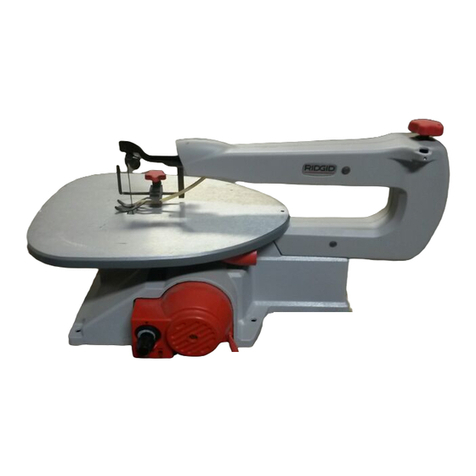
RIDGID
RIDGID SS1650 1 owner's manual
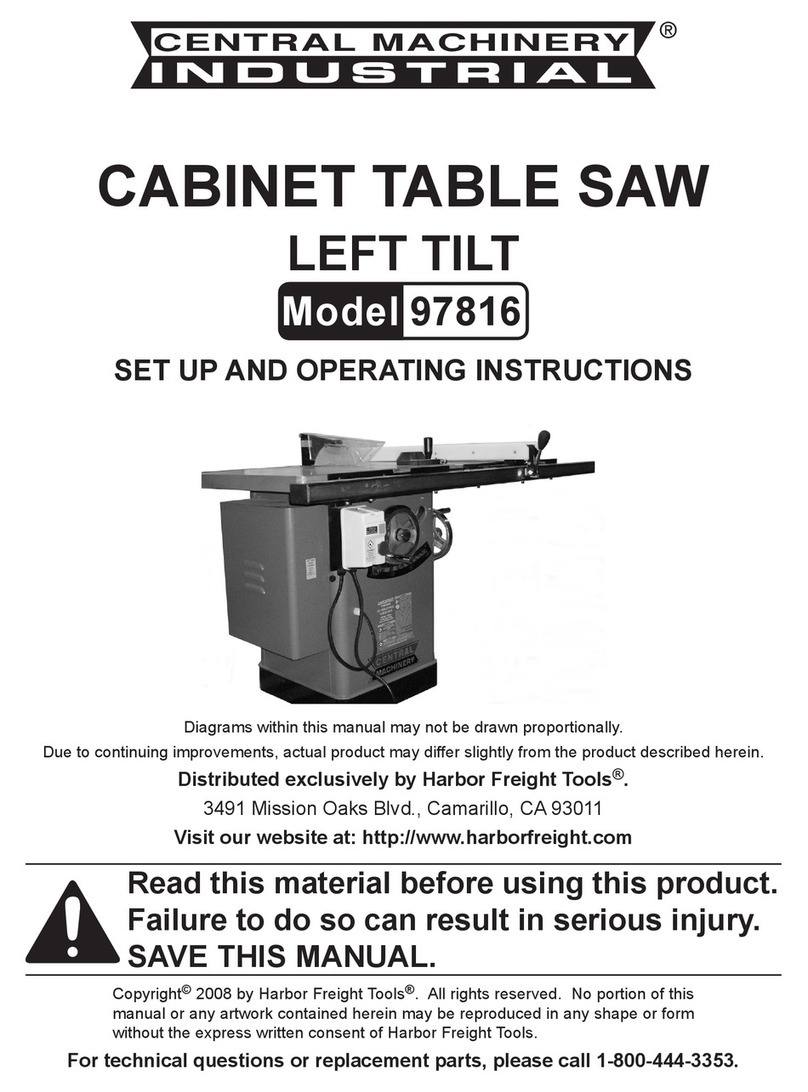
Central Machinery Industrial
Central Machinery Industrial 97816 Set up and operating instructions

HOLZMANN MASCHINEN
HOLZMANN MASCHINEN FKS400V32PRO 400V user manual
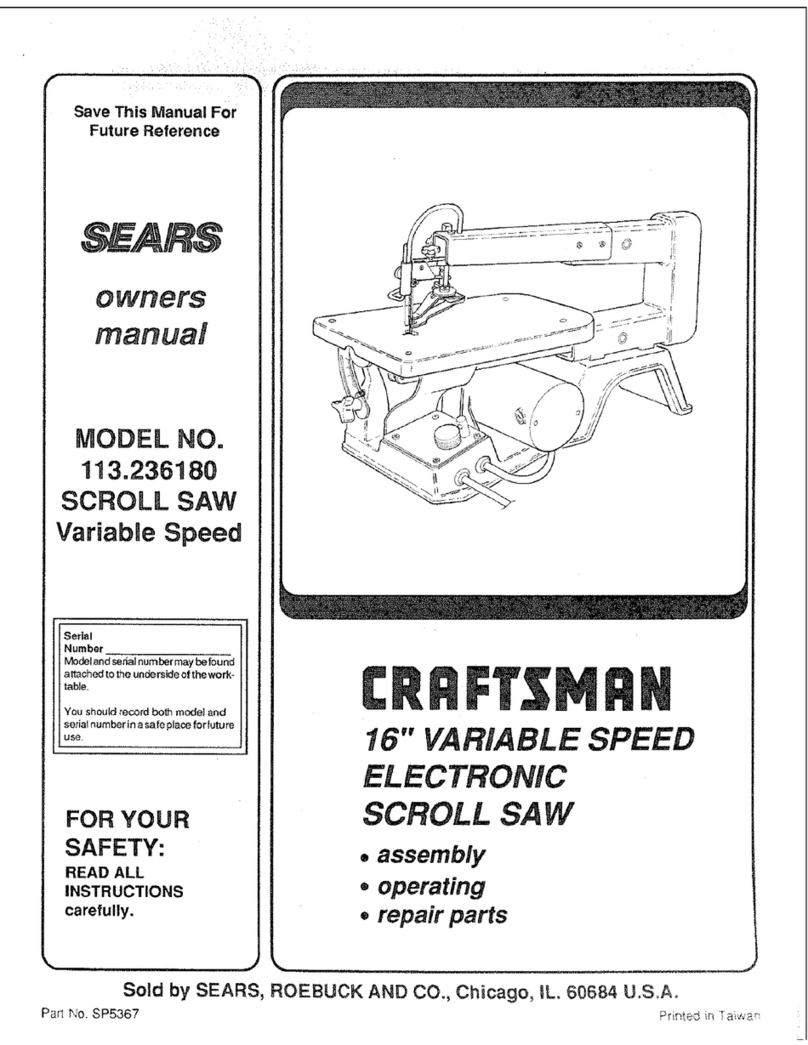
Sears
Sears Craftsman 113.236180 owner's manual

AL-KO
AL-KO KE 1800/35 instruction manual
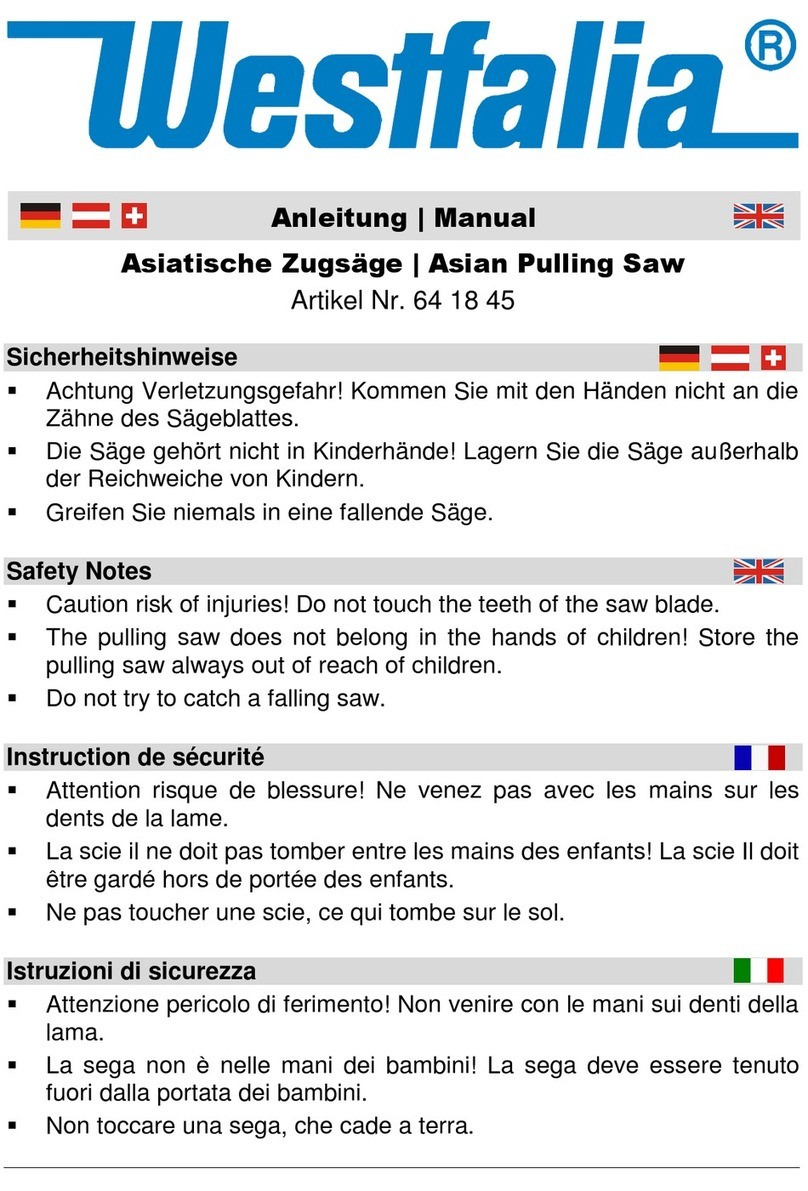
Westfalia
Westfalia 64 18 45 manual
